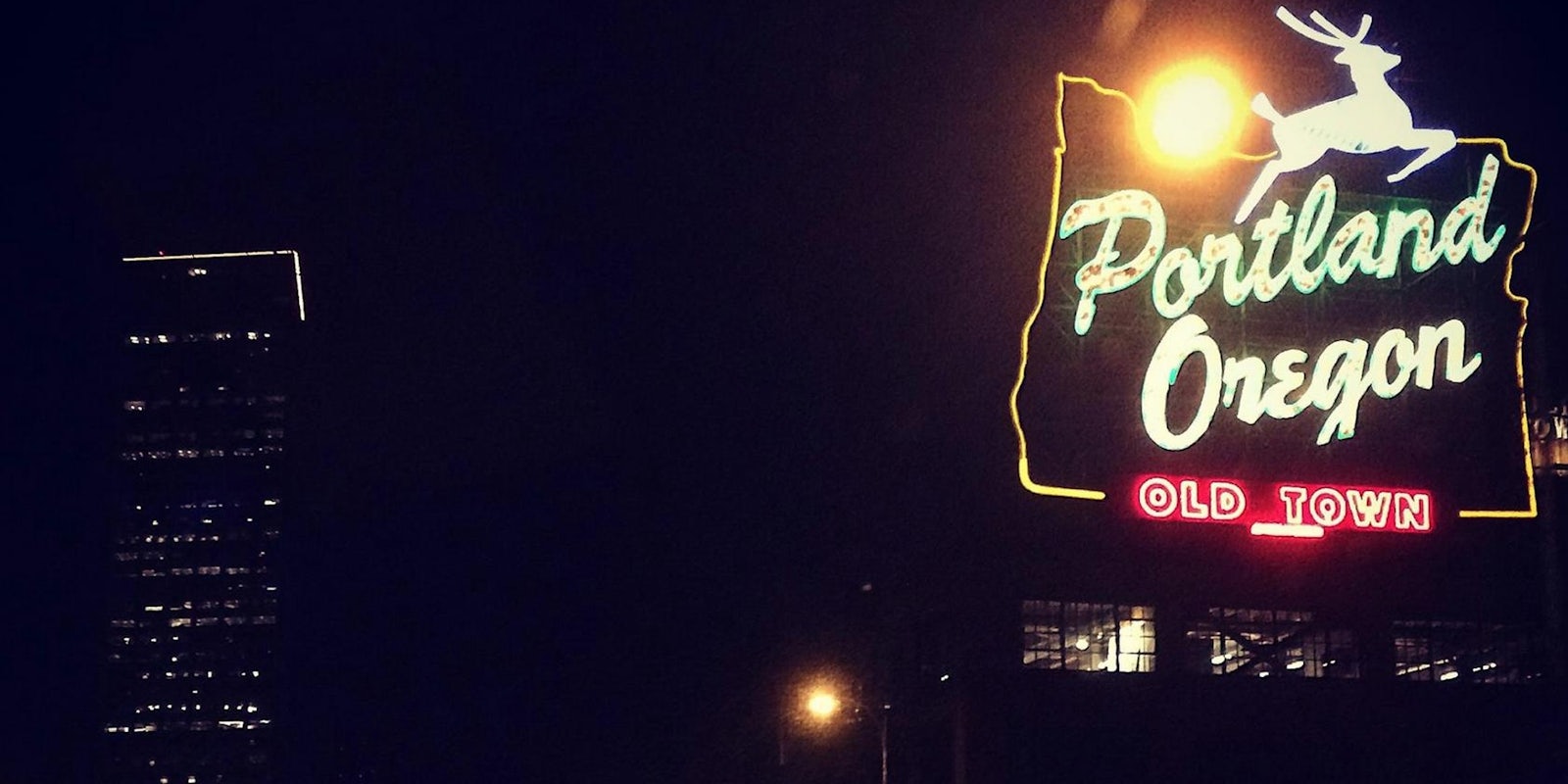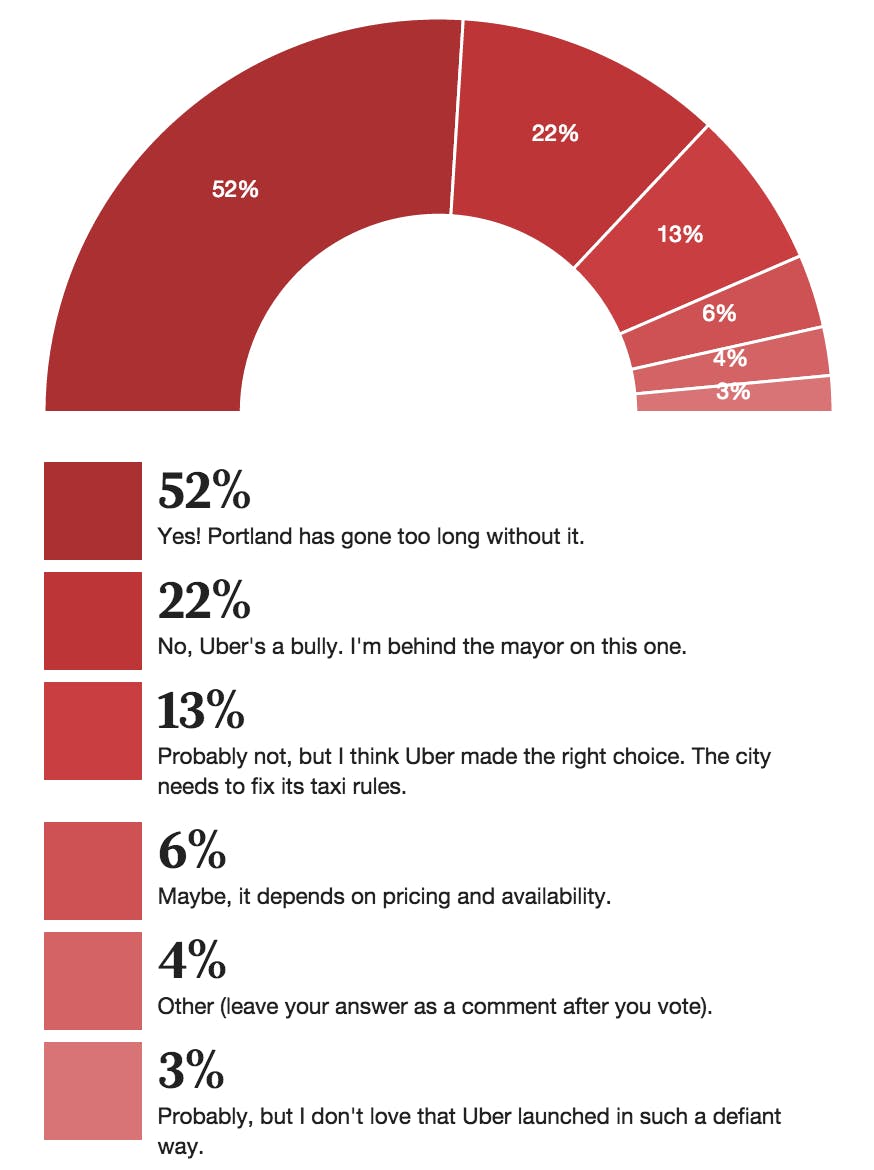Growing impatient with local regulations, the ridesharing app Uber stormed into the city of Portland, Ore. and began illegal operations nearly a week ago. While the fines the city will levy on the San Francisco-based company are hardly an obstacle considering Uber’s $40 billion valuation, the company is eager to justify its decision to operate in spite of the law and city leaders forbidding it from doing so. Uber is even promoting a petition to Portland Mayor Charlie Hales from signers as far afield as New Zealand.
Beyond expanding its global footprint and stuffing more money into its coffers, Uber insists that it’s responding to a transportation crisis in the city of Portland. Here are some of the company’s major claims—and if you should buy them.
1. Portland wants Uber.
This claim is pretty true. Portland’s Uber detractors are a vocal group—and not a small one—but in a survey conducted by the Portland Business Journal, 52 percent of 850 respondents responded “Yes” to the question “Will you use Uber in Portland, even though it’s operating illegally?”
Even Portland’s Unipiper, who appeared as “Rider Zero” in an Uber promo video, is in favor of Uber. (Though he did note he’s not an ideal customer).
“As someone who most frequently commutes by bike, I’m not sure how much I will use a ride share, but I like the idea of diversifying Portland’s transportation options and giving people the freedom to choose.”
2. Portland needs “a safe, hassle-free transportation option.”
It’s not wholly clear what this statement from Uber’s Portland petition even means, but one thing is evident: Portland has some of the best transportation options in the nation. The city tends to show up on lists reflecting that fact, like the U.S. News & World Report ranking of the best U.S. cities for public transportation, which gauges the “best combination of public transportation investment, ridership, and safety.” According to the report, “Portland’s public transit provides riders with a variety of travel options, including buses, light rail, commuter rail, streetcars, and an aerial tram.”
That ranking doesn’t even take Portland bike culture into account, and the city is widely regarded as one of the most bikeable cities in the nation. According to a Bicycling.com report that ranks Portland number one, “The only large city to earn Platinum status from the League of American Bicyclists is a paragon of bike-friendliness, with 180 miles of bike lanes and 79 miles of off-street bike paths.”
Beyond that, the city also has cabs that can be hailed by phone or via an app, though not as many of them as some major cities, given its abundance of other options and the relative ease of urban parking.
“Portland is home to tens of thousands of people who are rightfully demanding a safer way to get around their city,” Uber writes. “With Uber, they finally have a ride when they need one.”
So, no, Uber is wrong on this one. Portland has a variety of safe ways to get around, more than many other cities. And Uber labeling itself as a paragon of safety is, frankly, laughable.
3. Drinking and driving
Uber cites its desire to cut down on drinking and driving as one of the imperatives forcing it to begin illegal operations in the city of Portland. In 2012, the state of Oregon saw 86 drunk driving fatalities, down from 207 in 2003. Oregon falls in the bottom 20 states for rates of drunk driving fatalities, while Texas—another state that’s seen considerable pressure from Uber—leads with 1,296 drunk driving related fatalities in 2012. One preventable death is too many, but drinking and driving is steadily declining and far from an epidemic in the state of Oregon.
Meanwhile, local cab companies are also aware of their role in reducing drunk driving.
Great job @RadioCab. Love it. pic.twitter.com/mF4IHIAKqS
— Jennifer Cox (@jicox) January 19, 2014
4. Higher earnings for drivers
Uber’s claims of driver earnings have proven to be consistently inflated. While the company said its median UberX driver salary was a whopping $90,000 per year, drivers widely report earning far less than that—and sometimes less than minimum wage.
To make sky-high numbers like the ones Uber frequently cites, cab drivers would need to work upwards of 70 hours per week, almost double those in a traditional work week. That said, traditional cab drivers might not make that much either and their wages, like Uber driver wages, will fluctuate with demand.
Traditional cab drivers struggle to make ends meet in Portland, though rideshare drivers for companies like Uber are not necessarily positioned to fare better in the local market.
According to an extensive Portland transportation report on local cab wages, “Drivers at non-driver owned companies typically work long hours—often 12-14 hours per day, 6-7 days per week—to be able to meet the required company payments, expenses, and provide income for their families.”
Drivers with Portland’s driver-owned taxi company, Radio Cab, have “significantly higher” incomes compared to those at non-driver-owned companies. That might bode well for rideshare services like Uber, but Portland’s demand for car services isn’t necessarily growing—and fewer barriers to entry inviting more drivers into the mix could exacerbate that problem.
“At issue is the possibility of
potentially decreasing the income of current drivers and companies by further diluting the available taxi fares
amongst additional taxis.Although traditional indicators have shown flat or decreased demand in recent years, resulting in no increase in
taxi permits, there are pockets of unfilled demand for taxis. Underserved areas include wheelchair accessible
taxi vehicles, late night and other peak demand service, and areas of the city farther out from downtown.
Executive sedans and shuttles have filled in some of these gaps in service.”
Notably, Uber has lobbied against pro-acessibility regulations in other cities, like Washington D.C. In response to criticisms, Uber launched UberWav, which “connects riders with licensed paratransit drivers and curb-to-curb service in vehicles that are equipped with ramps or lifts.”
Uber may offer some wheelchair accessible vehicles in select cities, but the company is still facing at least one lawsuit claiming that its service violates the Americans with Disabilities Act and criticizing a lack of training around mobility issues for Uber drivers.
Photo via Uber



